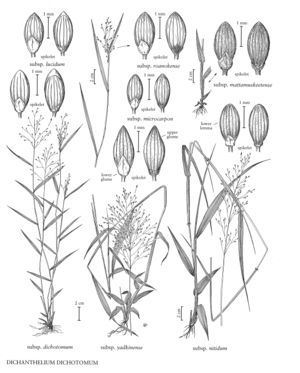Difference between revisions of "Dichanthelium dichotomum subsp. lucidum"
FNA>Volume Importer |
imported>Volume Importer |
||
| (4 intermediate revisions by 2 users not shown) | |||
| Line 6: | Line 6: | ||
|synonyms={{Treatment/ID/Synonym | |synonyms={{Treatment/ID/Synonym | ||
|name=Panicum sphagnicola | |name=Panicum sphagnicola | ||
| − | |authority= | + | |authority= |
| + | |rank=species | ||
}} {{Treatment/ID/Synonym | }} {{Treatment/ID/Synonym | ||
|name=Panicum lucidum | |name=Panicum lucidum | ||
| − | |authority= | + | |authority= |
| + | |rank=species | ||
}} {{Treatment/ID/Synonym | }} {{Treatment/ID/Synonym | ||
|name=Panicum dichotomum var. ludicum | |name=Panicum dichotomum var. ludicum | ||
| − | |authority= | + | |authority= |
| + | |rank=variety | ||
}} | }} | ||
|hierarchy=Poaceae;Poaceae subfam. Panicoideae;Poaceae tribe Paniceae;Dichanthelium;Dichanthelium sect. Dichanthelium;Dichanthelium dichotomum;Dichanthelium dichotomum subsp. lucidum | |hierarchy=Poaceae;Poaceae subfam. Panicoideae;Poaceae tribe Paniceae;Dichanthelium;Dichanthelium sect. Dichanthelium;Dichanthelium dichotomum;Dichanthelium dichotomum subsp. lucidum | ||
| Line 21: | Line 24: | ||
}}<!-- | }}<!-- | ||
| − | --><span class="statement" id="st-undefined" data-properties=""><b>Culms </b>occasionally more than 60 cm, very slender, weak; nodes usually glabrous; internodes often flattened, green, glabrous; fall phase with reclining or decumbent culms and numerous axillary branches, branches elongated and widely divergent, not forming fascicles. <b>Cauline</b> sheaths usually shorter than the internodes, glabrous; blades slightly smaller than those of the other subspecies, ascending or spreading, often lustrous, bright green, glabrous throughout. <b>Primary</b> panicles slightly smaller and with fewer spikelets than in the other subspecies (particularly subsp. dichotomum, which it closely resembles). <b>Spikelets</b> 1.8-2.3 mm, ellipsoid, usually glabrous, obtuse to subacute; upper florets 1.7-2 mm. <b>2n</b> = unknown.</span><!-- | + | --><span class="statement" id="st-undefined" data-properties=""><b>Culms </b>occasionally more than 60 cm, very slender, weak; nodes usually glabrous; internodes often flattened, green, glabrous; fall phase with reclining or decumbent culms and numerous axillary branches, branches elongated and widely divergent, not forming fascicles. <b>Cauline</b> sheaths usually shorter than the internodes, glabrous; blades slightly smaller than those of the other subspecies, ascending or spreading, often lustrous, bright green, glabrous throughout. <b>Primary</b> panicles slightly smaller and with fewer spikelets than in the other subspecies (particularly <i></i>subsp.<i> dichotomum</i>, which it closely resembles). <b>Spikelets</b> 1.8-2.3 mm, ellipsoid, usually glabrous, obtuse to subacute; upper florets 1.7-2 mm. <b>2n</b> = unknown.</span><!-- |
-->{{Treatment/Body | -->{{Treatment/Body | ||
| − | |discussion=<p>Dichanthelium dichotomum subsp. lucidum grows in wet woods, the margins of cypress swamps, sphagnum bogs, and other similar, wet habitats. It is primarily a species of the coastal plain, ranging from New Jersey to Florida, southeastern Texas, and up the Mississippi embayment to western Tennessee and, as a disjunct, on the Indiana Dunes of Lake Michigan.</p> | + | |discussion=<p><i>Dichanthelium dichotomum </i>subsp.<i> lucidum</i> grows in wet woods, the margins of cypress swamps, sphagnum bogs, and other similar, wet habitats. It is primarily a species of the coastal plain, ranging from New Jersey to Florida, southeastern Texas, and up the Mississippi embayment to western Tennessee and, as a disjunct, on the Indiana Dunes of Lake Michigan.</p> |
|tables= | |tables= | ||
|references= | |references= | ||
| Line 33: | Line 36: | ||
-->{{#Taxon: | -->{{#Taxon: | ||
name=Dichanthelium dichotomum subsp. lucidum | name=Dichanthelium dichotomum subsp. lucidum | ||
| − | |||
|authority=(Ashe) Freckmann & Lelong | |authority=(Ashe) Freckmann & Lelong | ||
|rank=subspecies | |rank=subspecies | ||
| Line 40: | Line 42: | ||
|basionyms= | |basionyms= | ||
|family=Poaceae | |family=Poaceae | ||
| − | |illustrator=Linda A. Vorobik | + | |illustrator=Linda A. Vorobik;Hana Pazdírková |
| + | |illustration copyright=Utah State University | ||
|reference=None | |reference=None | ||
|publication title= | |publication title= | ||
|publication year= | |publication year= | ||
|special status= | |special status= | ||
| − | |source xml=https:// | + | |source xml=https://bitbucket.org/aafc-mbb/fna-data-curation/src/200273ad09963decb8fc72550212de541d86569d/coarse_grained_fna_xml/V25/V25_1177.xml |
|subfamily=Poaceae subfam. Panicoideae | |subfamily=Poaceae subfam. Panicoideae | ||
|tribe=Poaceae tribe Paniceae | |tribe=Poaceae tribe Paniceae | ||
Latest revision as of 17:55, 11 May 2021
Culms occasionally more than 60 cm, very slender, weak; nodes usually glabrous; internodes often flattened, green, glabrous; fall phase with reclining or decumbent culms and numerous axillary branches, branches elongated and widely divergent, not forming fascicles. Cauline sheaths usually shorter than the internodes, glabrous; blades slightly smaller than those of the other subspecies, ascending or spreading, often lustrous, bright green, glabrous throughout. Primary panicles slightly smaller and with fewer spikelets than in the other subspecies (particularly subsp. dichotomum, which it closely resembles). Spikelets 1.8-2.3 mm, ellipsoid, usually glabrous, obtuse to subacute; upper florets 1.7-2 mm. 2n = unknown.
Discussion
Dichanthelium dichotomum subsp. lucidum grows in wet woods, the margins of cypress swamps, sphagnum bogs, and other similar, wet habitats. It is primarily a species of the coastal plain, ranging from New Jersey to Florida, southeastern Texas, and up the Mississippi embayment to western Tennessee and, as a disjunct, on the Indiana Dunes of Lake Michigan.
Selected References
None.
